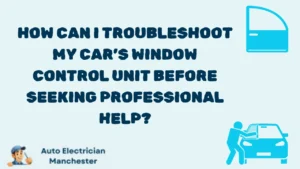
Imagine this: you’re cruising down the highway on a beautiful day, wanting to enjoy the fresh air. You reach for the window button, ready to let the breeze in, but nothing happens. Your window is stuck firmly in place. This frustrating scenario can be caused by a failing window control unit, also known as a power window switch.
A window control unit is the mastermind behind your car’s electric windows. It’s the central hub that receives signals from the window switches and transmits them to the window motors, ensuring smooth operation. A faulty control unit can disrupt this communication, leading to a range of inconveniences and even security risks.
How to Spot a Failing Window Control Unit?
Fortunately, your car will often give you hints that the window control unit is on its way out. Here are some key signs to watch out for:
Uneven Window Movement
A healthy window should glide effortlessly up and down. If your window travels at erratic speeds, jerks inconsistently, or struggles to reach its full range of motion, it could be a sign of a malfunctioning control unit. The unit might not be sending consistent signals to the motor, resulting in these uneven movements.
Unusual Noises from Your Window
Strange sounds are never a good sign when it comes to your car’s electrical components. If you hear grinding, clicking, or whirring noises while operating the windows, it could indicate a failing control unit. These sounds might be caused by the unit struggling to deliver power to the motor or internal components wearing down.
Frustrating Window Stalls
Imagine you’re trying to roll down your window to pay for a toll, but it gets stuck halfway. This scenario, along with windows that refuse to budge entirely, can be a sign of a power issue originating from the control unit. The unit might be malfunctioning and unable to send the necessary signal to the motor to operate the window.
Erratic Button Response
Sometimes, the problem might not lie with the window itself, but with the control unit’s communication with the switch. If pressing the window button produces no response, or requires repeated presses to work, the control unit might be faulty. The unit might not be properly registering the signal from the switch, leading to this erratic behavior.
Inconsistent Power Distribution
If only one window is affected by these malfunctions, it could be an isolated issue with that specific window’s motor or regulator. However, if multiple windows are exhibiting these symptoms simultaneously, the control unit responsible for supplying power to all windows is likely the culprit. Since a single unit controls multiple windows, a failure within the unit would affect all the windows it’s responsible for.
What to Do When Your Window Control Unit Fails?
By recognizing these signs early on, you can address the problem before it leaves you with a security vulnerability – an open window makes your car an easy target for theft – or an inconvenient window malfunction during unpredictable weather.
If you suspect a failing window control unit, the best course of action is to consult a qualified mechanic. They can pinpoint the exact cause of the problem through diagnostic tools and inspections. In some cases, cleaning the window switch contacts or replacing a blown fuse might be enough to solve the issue. However, if the control unit itself is faulty, a replacement will likely be necessary.
Window Control Unit Replacement
Replacing a window control unit might seem like a daunting task, but don’t worry! A skilled mechanic can handle the job efficiently, restoring your windows to their proper operation. The exact repair process will vary depending on your car’s make and model, but generally involves accessing the door panel, removing the faulty unit, and installing a new one.
Keeping Your Windows Rolling Smoothly
While window control units are typically durable components, there are steps you can take to extend their lifespan and prevent premature failure:
- Avoid excessive window use: Constant use, especially in extreme weather conditions, can put strain on the control unit and motor. Try to use your windows strategically, and consider opening the sunroof for ventilation instead of rolling down all the windows simultaneously.
- Keep your windows clean: Dirt, debris, and grime can accumulate on the window tracks, increasing the effort required by the motor and potentially straining the control unit. Regularly clean the window tracks to ensure smooth operation.
- Lubricate the window tracks: A light application of silicone lubricant on the window tracks can minimize friction and prevent the motor from working harder than necessary.
- Address minor issues promptly: Don’t ignore minor window malfunctions like slow movement or unusual noises. Prompt attention to these issues can prevent them from escalating into bigger problems that require replacing the control unit.
Cost to Replace Window Control Unit
The cost of replacing a window control unit can vary depending on several factors, including:
- Make and model of your car: Luxury car brands and newer models tend to have more expensive window control units.
- Parts availability: If the control unit for your specific car is rare or difficult to find, the cost will likely be higher.
- Labor costs: Mechanic labor rates can vary depending on your location and the complexity of the repair.
As a general estimate, expect to pay anywhere between $100 and $500 for a window control unit replacement. In some cases, the cost could be higher if additional parts, such as the window switch itself, need to be replaced as well.
Window Control Unit vs Window Regulator
While the window control unit and window regulator are both essential components for operating your car’s windows, they serve distinct purposes:
- Window control unit: The window control unit acts as the brain of the operation. It receives signals from the window switch and transmits them to the window regulator, essentially telling the regulator what to do (open, close, stop).
- Window regulator: The window regulator is the muscle behind the movement. It’s the mechanical assembly that uses power from the motor to physically raise and lower the window glass.
It’s important to distinguish between the two components because the symptoms of failure can be similar. If your window is experiencing movement issues, unusual noises, or gets stuck, it could be either the control unit or the regulator malfunctioning. A mechanic can diagnose the specific culprit through a proper inspection.
Do All Cars Have One Control Unit?
In most modern cars with electric windows, there is a single window control unit that manages all the windows. This unit is typically located on the driver’s side door panel and provides individual switches for each window.
However, there are some exceptions. Older cars or certain high-end models might have separate control units for specific windows, such as those in the rear passenger doors. Additionally, some convertibles have a separate control unit for operating the roof.
Window Control Unit Programming
In some modern cars, the window control unit might require programming after replacement. This programming process ensures proper communication between the new unit and the car’s computer system. The programming procedure can be as simple as using a scan tool or following specific button presses on the window switch itself, depending on the car model.
A qualified mechanic will have the necessary tools and knowledge to program the new window control unit if required for your car.
Conclusion
A failing window control unit can be a frustrating inconvenience. However, by recognizing the warning signs and taking prompt action, you can avoid security risks and ensure the smooth operation of your car’s windows. Consulting a qualified mechanic for diagnosis and repair is essential to get your windows rolling smoothly again.
FAQ
Can a blown fuse cause window problems?
Yes, a blown fuse can sometimes cause window problems. There is typically a fuse specifically for the power windows circuit. If this fuse blows, it can disrupt power delivery to the window control unit and windows, rendering them inoperable. Check your car’s owner’s manual to locate the window fuse and see if it’s blown.

David Mack is a seasoned writer with a passion for the auto electrician niche. With years of hands-on experience and a knack for demystifying complex topics, David brings practical insights to his readers. Whether you’re a professional or a car enthusiast, his engaging articles offer valuable tips and trends in auto electrical systems.
